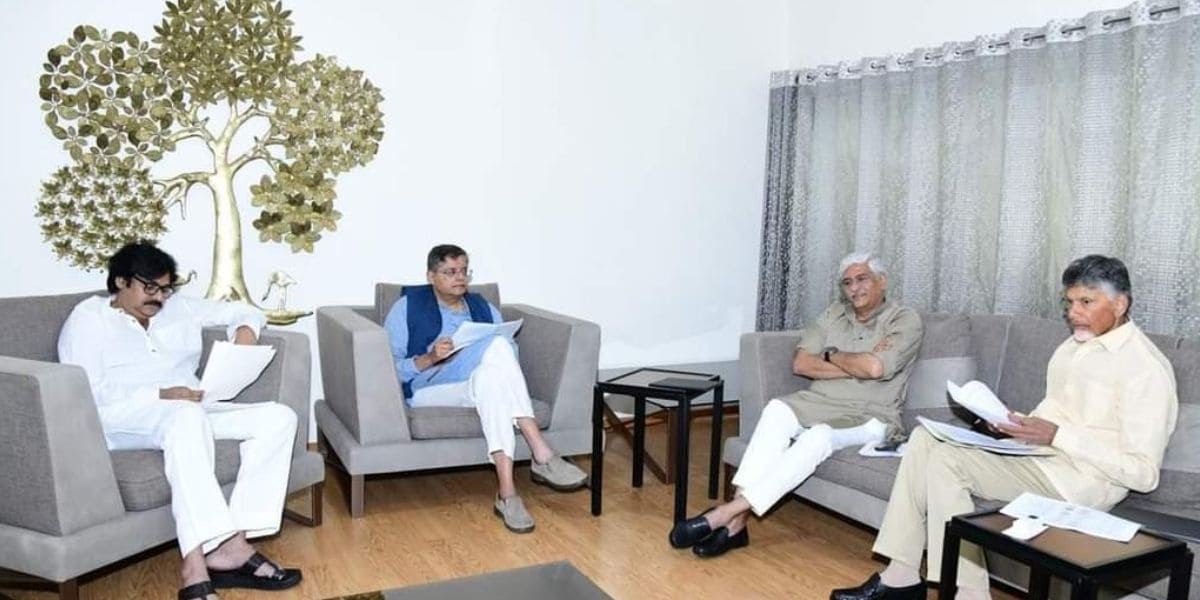Despite joining the alliance late, the BJP appeared to be the major beneficiary, paving the way for its establishment in the state.
Published Mar 12, 2024 | 8:35 AM ⚊ Updated Mar 12, 2024 | 8:35 AM

JSP chief Pawan Kalyan (Left), BJP Vice president Baijayant Jay Panda, Union Minister Gajendra Singh, and Chandrababu Naidu (Right). (Supplied)
The BJP finalised its poll alliance with the TDP and the Jana Sena Party (JSP) in Andhra Pradesh on Monday, 11 March.
After much deliberations that spread over weeks, the BJP would now contest in six Lok Sabha constituencies and 10 Assembly segments. Earlier the talks indicated that BJP would get six Parliament and six Assembly constituencies despite the saffron party wanting seven parliament seats.
To make up for one less seat in Lok Sabha elections 2024, BJP has been given four additional seats for Assembly elections in Andhra Pradesh, largely from Jana Sena’s kitty.
Elections to Parliament and Assembly would be conducted simultaneously in Andhra Pradesh.
The final round of meetings of the three parties was held at TDP national president N Chandrababu Naidu’s residence at Undavalli, a southern neighbourhood of Vijayawada, on Monday. Union Minister Gajendra Singh Shekhawat, BJP’s national vice president Baijayant Jay Panda, and JSP actor-politician Pawan Kalyan attended the close to eight-hour meeting.
According to the seat-sharing pact, the TDP would seek the mandate in 144 of the total 175 Assembly segments. The JSP, which had earlier announced its plan to contest in 24 seats, settled for 21.
Of the 25 Lok Sabha seats, the TDP got 17 and JSP two, one down from the earlier announced three.
The BJP had been seeking seven Lok Sabha seats, but the TDP was willing to give it only six. However, the saffron party got more Assembly seats and the JSP and the TDP gave it three and one seat, respectively, from their kitty.
It was earlier reported that the BJP would be contesting in six Assembly segments.
Despite joining the regional alliance of TDP and JSP late, the BJP appeared to be the major beneficiary, paving the way for its establishment in the state.
The BJP contested alone in 2019, and suffered a poll debacle, securing lesser than one percent votes in both Assembly and Parliament elections.
For the JSP workers, 21 Assembly seats might look too “less” for a “big” leader like Kalyan, who has been riding the aspirations of his supporters with around six percent vote share in the previous election. He was also projected as a chief minister from the Kapu community.
The JSP’s share has been seen as the price it paid for pursuing the alliance, despite the initial reluctance of the BJP and TDP.
However, political circles have been viewing the latest figures as an investment for the JSP, since Kalyan “personally” wanted to see YS Jagan Mohan Reddy’s defeat.
Incidentally, the BJP and TDP workers were initially against an alliance.
The district leaders justified that they had worked for the party for years but were forced to remain in the shadow of Andhra Pradesh’s bipolar political landscape, where the two regional parties — the YSRCP and TDP — held sway. They now wanted to be seen and heard in the state’s mainstream politics.
The leaders feared that the alliance with the TDP would obliterate their opportunity to emerge from the shadows.
Earlier, a meeting convened by BJP’s national leaders witnessed the party’s district office-bearers vehemently opposing the alliance with the TDP.
However, they changed their mind — albeit reluctantly — after senior leaders, including Kiran Kumar Reddy and Rajya Sabha member CM Ramesh, favoured a tie-up with the TDP and the JSP.
A section of TDP leaders, too, against the alliance. They argued that Naidu is cutting the BJP too much slack in his eagerness to rejoin the NDA. This, they feared, could prove detrimental to the TDP, a formidable political force in the state, while being a windfall for the BJP, which lacked a substantial presence.
The BJP’s performance in the 2019 Lok Sabha elections, with less than one percent — 0.98 percent to be exact — of the total votes polled, has raised questions about its electoral strength in the region. In Assembly elections, it was much worse: It polled only 0.84 percent.
Edited by Majnu Babu.
